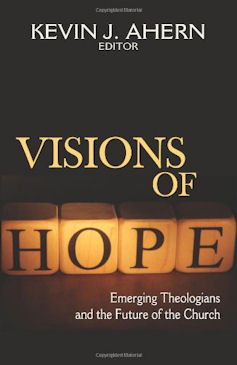
|
Posted July 17, 2013
Book: Visions of Hope: Emerging Theologians and the Future of the Church Author: Kevin J. Ahearn, Editor. Orbis Books. Maryknoll, NY. 2013. Pp. 261 An Excerpt from the Jacket:
Fifty years after the Second Vatican Council, emerging theologians are in a unique position to offer hopeful visions for the next fifty years in light of the pressing internal and external challenges the church faces today. Rooted in the texts of Vatican II and a deep commitment to the church, Visions of Hope brings together the research of leading young scholars around five important topics: dialogue, ecclesiology, ethics, liturgy,, and ministry. These ideas represent the future shape of the church because they are from the theologians who are planting the seminal ideas of the church of tomorrow. Excerpt from the Book: Vatican II: Shifting Worldview, Shifting Anthropology Although written under the pontificate of Paul VI, Gaudium et Spes actually recalls the legacy of John XXIII's view of the church and its relationship with the world. During his pontificate the church was confronted with a rapidly changing world characterized by internationalization and economic integration. The increasing economic interdependence contrasted with a lack of political and cultural unity; the world seemed more divided than ever between West and East (as the Cold War clearly showed) and between North and South (as former colonies' struggles for independence illustrated). Yet these threats did not undermine John XXIII's hope; he gave witness to a remarkable optimism and openness to worldly development, resulting in a new perspective on the relationship between the church and the world. It had only been one century earlier that Pius IX had promulgated Syllabus Errorun (1864), which condemned the "mistakes" of modernity and liberalism. This suspicion with regard to modernity resulted in a general opposition to the world and its development, one that characterized later pontificates until John XXIII. For example, Leo XIII's retrieval of neo-Scholastic Thomism was a strategy to avoid the threat he saw modernity posing to the faith. Politically, the papacy was often more concerned with local politics as the battlefield for the church's power struggle, as the focus on the relationship between church and state within official teachings illustrates. Unlike his predecessors, John XXIII recognized the crucial importance of social problems for revealing to us the "signs of the times" that must be discerned -- even at the global level. Instead of using politics to achieve his own goals, he aimed to build a new world together with others -- even if they were socialist or communist. This concern for, but also openness to, the possibilities the world offers stimulated him to announce a new Vatican council that should reflect and inspire aggiornamento. As such, John XXIII was shown to be a true cosmopolitan, who attempted to end the church's "fortress mentality." Table of Contents: 1. Introduction: looking to the future with hope ---Kevin J. Ahern Is Vatican II still relevant? Massimo Faggioli 2. Liturgy in the twenty-first century --- Benjamin Durheim Our fragile flesh: sacramental hospitality toward persons with intellectual disabilities and its implications --- Elizabeth L. Antus Mystical Body: An ecclesiology informed Judith Butler – Gina Ingiosi 3. Ministry for the Future --- Nathaniel Hibner 4. The Future of Dialogue --- Christopher Conway 5. The Enduring Ethical Vision of Gaudium et Spes: Catholic Moral Engagement in the Twenty-First Century --- Michael P. Jaycox 6. The Future of Ecclesiology --- Stephen Okey |
|
